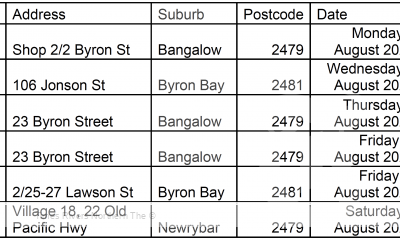Byron Shire Becomes First NSW Community to Enforce 60-Day Cap on Holiday Lets
As of the 23rd September, Byron Shire has become the first community in New South Wales to introduce legally enforceable measures regulating short-term holiday accommodation, marking a significant milestone in the region’s decade-long battle to tackle housing shortages. After years of campaigning, the Shire has officially implemented a 60-day cap on un-hosted short-term rental accommodation (STRA) in most parts of the area, in an effort to balance tourism demand with the critical need for long-term housing.
Tamara Smith, MP for Ballina, who has been a driving force behind this initiative, hailed the cap as a much-needed tool to help reclaim housing for permanent residents. “Since 2015, we have worked tirelessly with the community to have the power to rein in unfettered holiday letting in Byron Shire,” Smith said.
At the height of the STRA surge, entire homes in the Shire were being listed on holiday rental platforms, severely limiting the availability of long-term rentals for residents. “At peak times, we have seen thousands of whole homes on holiday sites while permanent residents have had no rentals available,” Smith explained, underscoring the strain this has placed on the local community.
Aiming to Relieve the Housing Crisis
The new 60-day cap, which applies to non-hosted STRA lodgings, is designed to ease this burden by encouraging property owners to move more homes back into the long-term rental market. “This cap should see the transfer of some of those properties to the long-term rental market and cannot kick in soon enough,” said Smith.
By limiting the number of days a property can be rented out as a holiday let, the Shire hopes to increase the supply of rental properties available for permanent residents. However, Smith warned that larger corporations and STRA platforms may push back against this change, viewing it as a threat to their interests. “Let’s be clear – the big corps will want this unique trial for our community to fail,” she cautioned.
In response, the local government is working closely with residents to promote the positive impacts the cap is expected to generate. “We are working closely with the community to amplify the good news stories that we expect to emerge from this new power our community now has,” Smith added.
A Community-Driven Effort
Byron Shire, known for its popularity as a coastal holiday destination, has also faced significant challenges in recent years, including devastating fires and floods. Smith highlighted the resilience of the community in the face of these disasters, noting that the introduction of the cap represents another crucial step in rebuilding and strengthening the region. “As a community, we have faced fires and floods with incredible resilience, and there is palpable relief to have what I hope will be an effective piece of the puzzle toward alleviating the housing crisis in Byron Shire,” she said.
Despite expectations that rents in Byron Shire will remain relatively high, Smith is optimistic that increasing the supply of available homes for long-term rental will gradually help stabilise costs. “We know that rents in Byron Shire will be high, but supply over the long term will make a difference to both cost and availability,” she explained.
Exemptions and Future Implications
The 60-day cap will apply across the majority of Byron Shire, with two exceptions: specific precincts in Byron Bay and Brunswick Heads. These areas, which are particularly popular with tourists, have been excluded from the cap for the time being.
Smith hopes that Byron Shire’s lead in introducing these measures will inspire other communities across NSW to follow suit, especially as the state grapples with a broader rental crisis. “NSW is in a rental crisis, and it is my hope that Byron Shire will lead by example in the re-establishment of community amenity and the prioritisation of homes for permanent residents,” Smith said.
Monitoring and Future Adaptations
While the cap represents a significant step forward, Smith emphasised that it is only the beginning of the process. The MP confirmed that she will be closely monitoring the implementation of the 60-day cap and its impact on both the local housing market and the operations of STRA companies.
“It is important to see what works and what doesn’t as we move forward,” Smith said. She believes the success of the Byron Shire model could pave the way for other communities across the state to take control of STRA when investor activity starts to negatively impact housing availability and community cohesion. “Our model can set the path toward all communities in NSW having the power to rein in STRA when the balance tips too far towards property investors and big corporations, away from residential amenity and housing availability for permanent residents,” she concluded.
A Critical First Step
As Byron Shire takes this bold step towards alleviating its housing crisis, it marks a significant moment not just for the region, but potentially for all of New South Wales. The introduction of the 60-day cap on short-term holiday rentals is seen as a crucial experiment, with the rest of the state watching closely to see how this pioneering policy will impact the housing market and community well-being in one of Australia’s most sought-after regions.
How will it be enforced?
The enforcement of the 60-day cap on un-hosted short-term rental accommodation (STRA) in Byron Shire will be managed through a combination of local government oversight, monitoring systems, and penalties for non-compliance.
Key Enforcement Measures:
- Registration and Tracking: Property owners who wish to offer short-term rentals must register their properties with the NSW Government’s short-term rental accommodation register. This central database helps local authorities monitor the number of days a property is rented out annually. The registration system allows for accurate tracking to ensure that un-hosted properties do not exceed the 60-day cap.
- Data Sharing from STRA Platforms: Major STRA platforms like Airbnb and Stayz will be required to share data with local councils and the state government. These platforms track booking information, making it easier to verify how many days a property has been rented. This collaboration ensures that authorities have access to real-time data and can identify potential breaches of the cap.
- Fines and Penalties: Property owners who fail to comply with the 60-day limit face financial penalties. If a property exceeds the cap, local councils can issue fines and other enforcement measures. While specific fine amounts may vary, non-compliance could result in significant penalties to deter violations.
- Community Reporting: The local community plays an important role in enforcing the cap. Residents can report properties they suspect of violating the 60-day limit, providing another layer of oversight. These reports can be submitted directly to the council for investigation.
- Random Audits and Inspections: To ensure compliance, the local council may conduct random audits or inspections of STRA properties. These audits can include reviewing booking records, STRA platform listings, and other relevant documentation.
- Education and Awareness: In the early stages of implementation, there will likely be an emphasis on educating property owners about the new regulations and the importance of compliance. This will help ensure that landlords understand the rules and avoid accidental breaches of the 60-day cap.
The effectiveness of enforcement will depend on how well these mechanisms are integrated and supported by cooperation between local authorities, STRA platforms, and the community. Over time, the council may adjust enforcement strategies based on the results of the initial rollout and any challenges that arise.





 Tweed Shire News2 years ago
Tweed Shire News2 years ago
 Motoring News2 years ago
Motoring News2 years ago
 COVID-19 Northern Rivers News3 years ago
COVID-19 Northern Rivers News3 years ago
 COVID-19 Northern Rivers News3 years ago
COVID-19 Northern Rivers News3 years ago
 Northern Rivers Local News3 years ago
Northern Rivers Local News3 years ago
 Health News3 years ago
Health News3 years ago
 COVID-19 Northern Rivers News3 years ago
COVID-19 Northern Rivers News3 years ago
 NSW Breaking News3 years ago
NSW Breaking News3 years ago

























